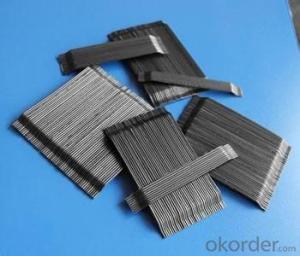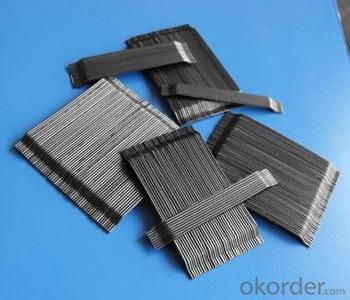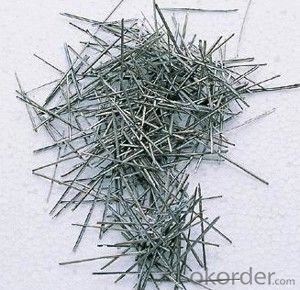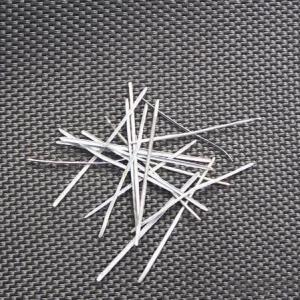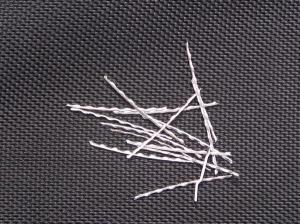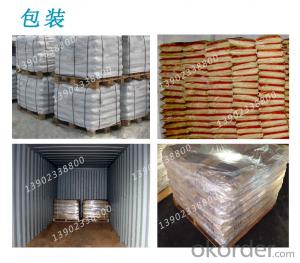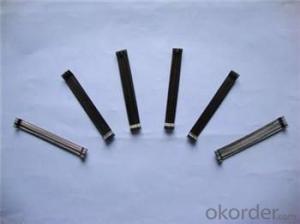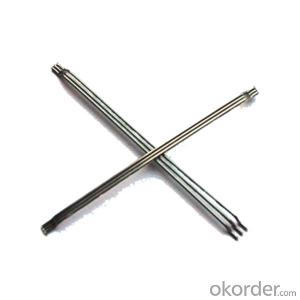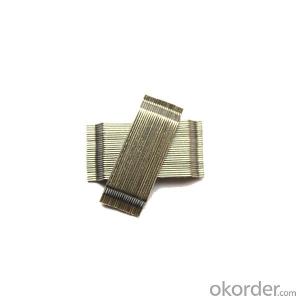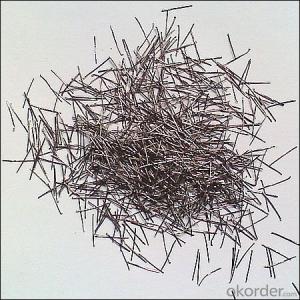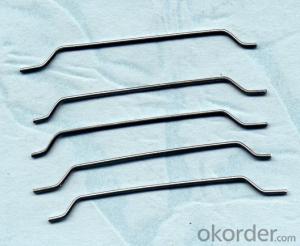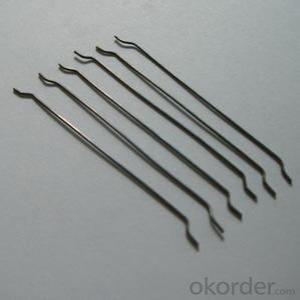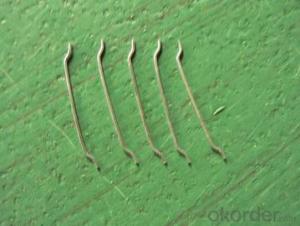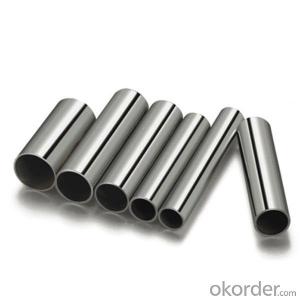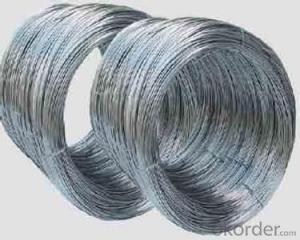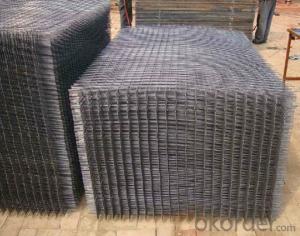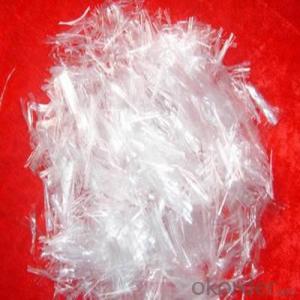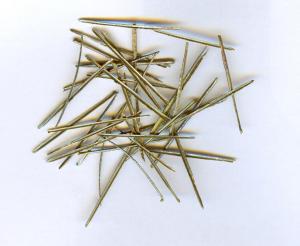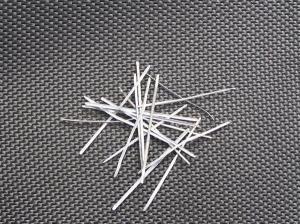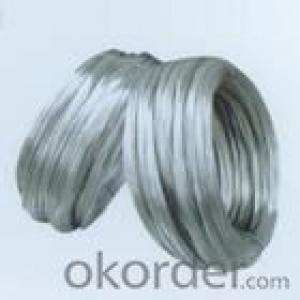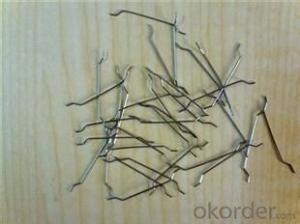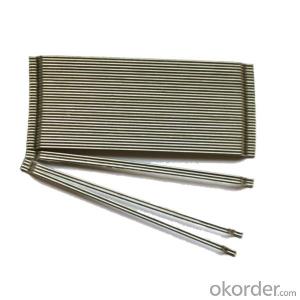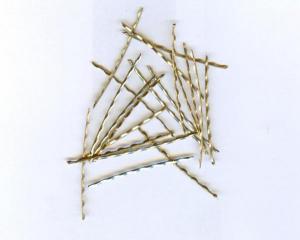Glued low Steel Fiber From Company CNBM China
- Loading Port:
- Tianjin
- Payment Terms:
- TT OR LC
- Min Order Qty:
- 1 m.t.
- Supply Capability:
- 600 m.t./month
OKorder Service Pledge
Quality Product, Order Online Tracking, Timely Delivery
OKorder Financial Service
Credit Rating, Credit Services, Credit Purchasing
You Might Also Like
Quick Details
Place of Origin: Tianjin, China (Mainland)
Model Number: 0.55 mm
Material: Steel
Production Process: Cold drawn
Lengh: 35
Type: 1
Compressive Strength: >1200MPa
Aspect ratio: 63
Standard: ASTM A820M-11
Section Shape: Circular
Application: Concrete Reinforcement
Packaging & Delivery
| Packaging Details: | 20 kg/Bag,50 bags/Pallet or 1,000kg/ Bulk Bag |
|---|---|
| Delivery Detail: | 1 Month |
Product Description
| Diameter | 0.55 mm | ||
| Length | 35 mm | ||
| Aspect Ratio | 63 | ||
| Tensile strength | 1200 MPa | ||
| Type | Cold drawn Steel Fiber | ||
| End | Hooked-end Steel Fiber | ||
| Glued/Loose | Glued Steel Fiber | ||
| Bending Angle | 45°(min.30°) | ||
| Usage & Performance | Floor:Trafficked areas and Industrial floors | ||
| Shotcrete :Slope stabilization and Final lining | |||
| Precast concrete:Pipe and Railway sleepers | |||
| Packing | Standard Export Pallet Packing | Bag Packing | 20 kg/Bag,50 bags/Pallet |
| Bulk Packing | 1,000kg/ Bulk Bag | ||
| Loading Quantity | 20’GP | 20-25 Tonne/Tonnes | |
| 40’GP | 25-27 Tonne/Tonnes | ||
| 40’HQ | 25-27 Tonne/Tonnes | ||
| MOQ | 1 kg for trial order | ||
| Supply Ability | 10,000 Tonne/Tonnes per Year | ||
| Payment Terms | T/T or L/C at sight | ||
| Delivery Time | Within 15 days after receiving deposit or original L/C at sight | ||
| Certification | ISO9001:2000, CE, | ||
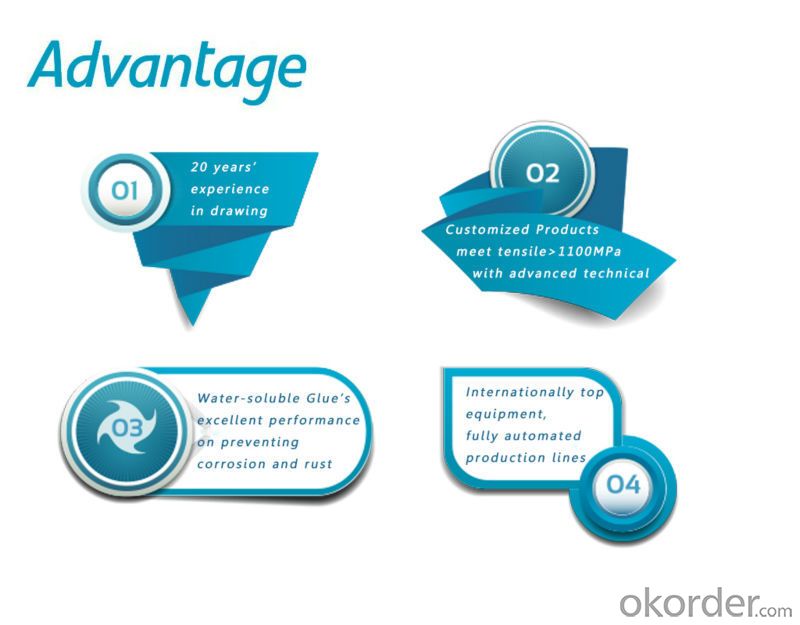
| Product | Diameter (mm) | Length (mm) | Aspect Ratio | Type | Packing |
| G-6030 | 0.5 | 30 | 60 | Glued | 20 kg/Bag, or 1,000kg/ Bulk Bag |
| G-6535 | 0.55 | 35 | 65 | Glued | 20 kg/Bag, or 1,000kg/ Bulk Bag |
| G-6035 | 0.6 | 35 | 60 | Glued | 20 kg/Bag, or 1,000kg/ Bulk Bag |
| G-8060 | 0.75 | 60 | 80 | Glued | 20 kg/Bag, 50 bags/Pallet |
| G-6060 | 0.9 | 60 | 60 | Glued | 20 kg/Bag, 50 bags/Pallet |
| G-6030 | 0.5 | 30 | 60 | Loose | 20 kg/Bag, or 1,000kg/ Bulk Bag |
| G-6535 | 0.55 | 35 | 65 | Loose | 20 kg/Bag, or 1,000kg/ Bulk Bag |
| G-6035 | 0.6 | 35 | 60 | Loose | 20 kg/Bag, or 1,000kg/ Bulk Bag |
| G-8060 | 0.75 | 60 | 80 | Loose | 20 kg/Bag, 50 bags/Pallet |
| G-6060 | 0.9 | 60 | 60 | Loose | 20 kg/Bag, 50 bags/Pallet |
- Q: Can melt extract stainless steel fiber be used in sports field pavements?
- Yes, melt extract stainless steel fiber can be used in sports field pavements. Stainless steel fibers are known for their high strength and durability, making them an excellent choice for applications that require resistance to wear and heavy traffic, such as sports field pavements. These fibers can improve the overall performance and lifespan of the pavement by enhancing its toughness, crack resistance, and fatigue resistance. Additionally, the corrosion resistance of stainless steel ensures that the fibers will not deteriorate over time, even in harsh weather conditions. Overall, using melt extract stainless steel fiber in sports field pavements can help create a more robust and long-lasting surface that can withstand the rigorous demands of sports activities.
- Q: C50 steel fiber concrete, the minimum price, who will tell
- This has to know the amount of steel fiber and kind of Caixing, different steel fiber price difference is quite big, mixing quantity is different, the cost difference is also very big.
- Q: What is the effect of melt extract stainless steel fiber on the modulus of rupture of shotcrete?
- The inclusion of melt extract stainless steel fiber in shotcrete can have a significant effect on the modulus of rupture. Modulus of rupture refers to the maximum amount of stress a material can withstand before it fails in a bending or tensile test. The addition of stainless steel fibers in shotcrete increases its tensile strength and flexural performance, leading to an improvement in the modulus of rupture. These fibers act as reinforcement within the shotcrete matrix, enhancing its overall mechanical properties. The stainless steel fibers distribute the stresses within the shotcrete more evenly, preventing the formation and propagation of cracks. This results in a higher modulus of rupture, as the shotcrete can withstand greater bending and tensile forces before failure occurs. Furthermore, the presence of stainless steel fibers also enhances the ductility of shotcrete. Ductility refers to the ability of a material to deform plastically before ultimate failure. The fibers create a bridge-like effect, allowing the shotcrete to deform and absorb energy before reaching its breaking point. This increased ductility further contributes to the improvement in the modulus of rupture. In summary, the incorporation of melt extract stainless steel fiber in shotcrete has a positive impact on the modulus of rupture. It enhances the material's tensile strength, flexural performance, and ductility, resulting in a higher resistance to bending and tensile forces. This makes shotcrete with stainless steel fibers a highly durable and reliable construction material, particularly suitable for applications requiring high strength and structural integrity.
- Q: What are the applications of melt extract stainless steel fiber?
- Melt extract stainless steel fibers have various applications in different industries. They are commonly used in concrete reinforcement to enhance the durability and strength of structures like bridges and pavements. These fibers also find application in high-temperature insulation materials, as they can withstand extreme temperatures and provide thermal resistance. Additionally, melt extract stainless steel fibers are used in the production of friction materials, such as brake pads, to improve their wear resistance and performance. Overall, these fibers offer excellent mechanical properties, corrosion resistance, and thermal stability, making them suitable for a wide range of applications.
- Q: What is the effect of melt extract stainless steel fiber on the early-age cracking of concrete?
- The use of melt extract stainless steel fiber in concrete can have a positive effect on reducing early-age cracking. Early-age cracking in concrete occurs due to a variety of factors, including temperature changes, shrinkage, and rapid moisture loss. Stainless steel fibers, when added to the concrete mix, provide reinforcement and enhance the overall tensile strength of the concrete. This reinforcement helps to control the formation and propagation of cracks during the early stages of concrete curing. The unique properties of melt extract stainless steel fibers, such as high tensile strength, corrosion resistance, and durability, make them an excellent choice for mitigating early-age cracking. These fibers effectively distribute stress throughout the concrete matrix, limiting crack initiation and propagation. Additionally, melt extract stainless steel fibers can also help to control plastic shrinkage cracking. During the initial stages of concrete curing, rapid moisture loss can cause the surface to shrink and crack. The addition of stainless steel fibers helps to restrain this shrinkage, reducing the likelihood of early-age cracking. It is important to note that the specific effect of melt extract stainless steel fiber on early-age cracking may vary depending on factors such as fiber dosage, concrete mix design, and environmental conditions. Therefore, it is essential to conduct thorough testing and consult with experts to determine the optimal fiber dosage and application for a specific project.
- Q: How does melt extract stainless steel fiber improve the resistance to sulfate attack in concrete?
- Melt extract stainless steel fiber improves the resistance to sulfate attack in concrete by providing enhanced durability and strength. The fibers create a three-dimensional reinforcement network within the concrete, which helps to distribute stress and prevent cracking caused by sulfate exposure. Additionally, the stainless steel fibers have excellent corrosion resistance properties, preventing the degradation of the concrete due to chemical reactions with sulfates. Overall, the incorporation of melt extract stainless steel fiber enhances the concrete's ability to withstand sulfate attack and increases its service life.
- Q: What is the effect of melt extract stainless steel fiber on the thermal conductivity of concrete?
- The inclusion of melt extract stainless steel fiber in concrete tends to enhance its thermal conductivity. The fibers act as heat conductors within the concrete matrix, facilitating the transfer of heat throughout the material. This results in improved thermal conductivity and better heat distribution within the concrete structure.
- Q: Is melt extract stainless steel fiber suitable for use in tunnel lining construction?
- Yes, melt extract stainless steel fiber is suitable for use in tunnel lining construction. It provides enhanced strength, durability, and resistance to corrosion, making it an ideal choice for reinforcing concrete in tunnels.
- Q: Is melt extract stainless steel fiber suitable for use in self-compacting concrete?
- Melt extract stainless steel fiber is indeed suitable for application in self-compacting concrete. This particular fiber is renowned for its exceptional resistance to corrosion and its impressive tensile strength, making it an ideal choice for reinforcing self-compacting concrete. In fact, these fibers have the ability to significantly enhance the mechanical properties of the concrete, including its flexural and tensile strength, as well as its ability to resist cracking and impact. Another advantage of melt extract stainless steel fibers is their high aspect ratio, which contributes to improving the cohesion and uniformity of the concrete mixture. Ultimately, utilizing melt extract stainless steel fiber in self-compacting concrete can result in a more resilient and sturdy material, making it appropriate for a wide range of construction applications.
- Q: Does melt extract stainless steel fiber improve the fire resistance of concrete?
- Yes, melt extract stainless steel fiber does improve the fire resistance of concrete. The addition of these fibers enhances the concrete's ability to withstand high temperatures, reduce cracking, and maintain its structural integrity during a fire.
Send your message to us
Glued low Steel Fiber From Company CNBM China
- Loading Port:
- Tianjin
- Payment Terms:
- TT OR LC
- Min Order Qty:
- 1 m.t.
- Supply Capability:
- 600 m.t./month
OKorder Service Pledge
Quality Product, Order Online Tracking, Timely Delivery
OKorder Financial Service
Credit Rating, Credit Services, Credit Purchasing
Similar products
Hot products
Hot Searches
Related keywords
